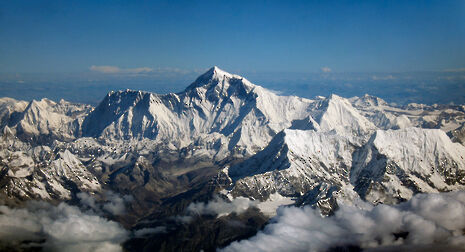Climbing Everest without oxygen
George Milner explores the physiological changes that elite mountaineers undergo in their ascent of the world’s highest mountain

Convincing the mind to climb to 8,848m without supplemental oxygen requires experience or insanity, along with an £8,700 permit. Convincing the body to take the mind there and back requires acclimatisation. How does this happen, and what are the broader implications for medical research?
In 1978, Reinhold Messner and Peter Habeler shocked the medical and mountaineering communities by reaching the top of Everest without supplemental oxygen. For good measure, Messner repeated the feat alone two years later. Of the more than 4,000 climbers to have summited the world’s highest mountain, just 200 have followed in their footsteps. There is good reason for this. Although during the ascent to altitude the atmospheric percentage of oxygen remains steady at 20.9%, atmospheric pressure falls significantly. While ascending from sea level to 5000m, just below the elevation of base camp, a climber will see atmospheric pressure halve. Make it to the summit and that will fall by a further third.
The region above 8000m is colloquially referred to by mountaineers as the “death zone” due to its inability to sustain human life for significant periods. In unacclimatised individuals, exposure to equivalent pressures consistently causes unconsciousness in under three minutes. In contrast, acclimatised mountaineers are able to survive for a few days at 8000m and make the further 848m ascent to the summit. How is this possible?
“Susceptibility to altitude sickness is, unsurprisingly, largely independent of bravado”
Classical physiological adaptation to altitude involves maximising oxygen delivery via respiratory, cardiovascular and haematological changes. The first hurdle is ensuring that the pressure of oxygen in the lungs, specifically in its small air sacs called alveoli, is sufficiently high. In the lungs, oxygen must compete for space with both CO2 and water vapour readily supplied by the body. Increases in breathing rate and depth blow off CO2 to leave more space for oxygen. This is supplemented too by changes which increase oxygen binding to haemoglobin in the blood at a given pressure. Of course, climbers, doctors and fast jet pilots alike can artificially increase the oxygen percentage in the alveoli with the use of supplemental oxygen of a higher concentration than in air, removing a further competitor, nitrogen.
There are limitations to what changes in breathing alone can achieve, however. This reality was demonstrated by recordings taken on the Xtreme Everest research expedition showing an average arterial blood oxygen saturation of only 54% in four climbers at 8,400m. A fall below 90% in an unacclimatised individual would set hospital alarm bells ringing. A fall to 54% would likely be fatal.
Crucially therefore for climbers, increasing blood oxygen saturation isn’t the only means of increasing oxygen delivery to starving tissues. Firstly, the oxygen content of the blood can be increased by increasing the concentration of red blood cells and oxygen-carrying haemoglobin in excess of 25%. This is naturally induced over a period of days to weeks by the hormone erythropoietin (EPO). High-altitude training seeks to stimulate this process in athletes. In contrast, supplementary EPO is banned by the World Anti-Doping Agency and has been the subject of high-profile doping cases, such as that of former cyclist Lance Armstrong.
Although it takes days to increase the concentration of red blood cells, altitude also causes a more rapid fall in blood volume which quickly concentrates red blood cells. While reduced blood volume is thought to be behind a small reduction in the amount of blood pumped by each heartbeat at altitude, increases in heart rate can not only effectively counter this but further increase delivery of blood to the rest of the body.
“Research into biomarkers for acclimatisation could be used for monitoring patients and predicting their responses to illness”
There is, however, more to the story. Classical explanations of acclimatisation struggle to explain observations that physiologically similar individuals show marked variation in performance at altitude. Maximum oxygen consumption can in fact decrease during acclimatisation without alterations in oxygen delivery capacity. The authors of a study comparing Messner and Habeler to a control group concluded that “elite high-altitude climbers do not have physiological adaptations to high altitude that justify their unique performance”. This hints at variation in the actual use of oxygen once delivered, the extent of which has genetic links. Some individuals may be more efficient at using oxygen and then require less of it once acclimatised, in keeping with observations of decreased usage in oxygen-deprived animals.
Susceptibility to altitude sickness is largely independent of age, physical fitness and, unsurprisingly, bravado. Low oxygen can cause dangerous build-ups of fluid in the lungs and brain in susceptible individuals at altitudes as low as 2500m. An increasing concentration of red blood cells increases blood viscosity, raising the risk of clotting and reducing blood flow through narrow vessels. This increases the risk of heart attacks and strokes. Tellingly, native Tibetans do not show as extensive an increase in red blood cell concentration as lowlanders but instead show changes in blood circulation.
Many climbers are therefore limited by altitude-related conditions brought about even before oxygen falls to levels that directly impair activity. To add further concern, MRI scans in 2006 of 13 climbers following attempts to climb Everest reported evidence of brain damage in all but one, despite the absence of reported altitude sickness.
Journals are awash with studies of high-altitude physiology for reasons that go beyond the allure of mountains to researchers. The processes by which the body acclimatises to altitude are also shown in patients with conditions that impair oxygen transfer such as emphysema and chronic heart disease. Research into biomarkers for acclimatisation could be used for monitoring patients and predicting their responses to illness. Already, lessons from the treatment of a build-up of fluid in the lungs at altitude have contributed towards understanding of the treatment of the event at sea level. From a research perspective, mountaineers can show similar symptoms to chronically ill patients, but crucially without the co-occurrence of other diseases that make determining the effects of a single medical intervention difficult.
The challenge of climbing Everest without supplemental oxygen is certainly one that pushes the body close to, or often beyond, its physiological and metabolic limits. Among the flow of mountaineers through base camp, there are already people for whom reaching the summit with supplemental oxygen simply isn’t enough of a challenge. With the Nepalese government’s decision to ban solo attempts in 2017, their number will surely increase further. This group in particular, and indeed all those who successfully ascend to high altitude, have the remarkable process of acclimatisation to thank.
 Comment / Plastic pubs: the problem with Cambridge alehouses 5 January 2026
Comment / Plastic pubs: the problem with Cambridge alehouses 5 January 2026 News / Cambridge businesses concerned infrastructure delays will hurt growth5 January 2026
News / Cambridge businesses concerned infrastructure delays will hurt growth5 January 2026 News / New movement ‘Cambridge is Chopped’ launched to fight against hate crime7 January 2026
News / New movement ‘Cambridge is Chopped’ launched to fight against hate crime7 January 2026 News / Uni-linked firms rank among Cambridgeshire’s largest7 January 2026
News / Uni-linked firms rank among Cambridgeshire’s largest7 January 2026 News / AstraZeneca sues for £32 million over faulty construction at Cambridge Campus31 December 2025
News / AstraZeneca sues for £32 million over faulty construction at Cambridge Campus31 December 2025









